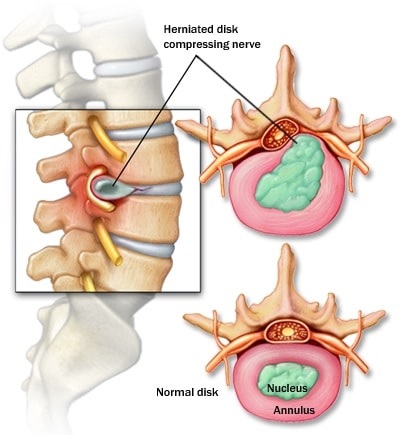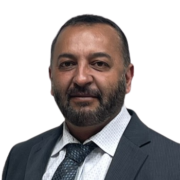Herniated Disc Symptoms & Treatment Options
Separating our vertebrae there are tiny “gel-like” filled cushions known as intervertebral discs. Intervertebral discs function to support, connect our spinal vertebrae, provide mobility and absorb impact between the adjacent bones of our spine. A herniated disc occurs when the exterior layer or casing of the disc fissures, breaks open or cracks, releasing its jelly-like interior into the spinal canal or nerve space. A ruptured disc often collapses upon itself, pinching nearby nerves and diminishing the spine’s ability to move, support and absorb compressive or expansive forces.
When we are young, our discs are resilient and rubbery. However, as we age, our discs loose hydration, deflate from impact of everyday wear and tear and sometimes from injury. As our discs degenerate, they undergo adverse changes, they lose their elasticity, suffer dehydration, and become more prone to disc herniation. An unexpected injury, such as a car accident, a fall, a forced flexion, extension, excess torsion, abrupt acceleration and deceleration or an impact, can cause these changes to occur instantaneously—instead of over the course of decades.
In addition, our vertebrae contain built-in passages that allow our nerves to fan out from the spinal cord to other regions of our body ( the so called nerve channels or foramina). These nerves control movement, balance, sensation, our awareness of posture and transmit pain. When these openings become obstructed because of herniated disc material or secondary collapse with compression, our spinal nerves often become pinched. Nerve impingement not only generates a great deal of pain, but can also lead to loss of sensation and motor control in our extremities.
Fortunately, herniated or slipped discs are highly treatable. Our team uses innovative, minimally invasive, and individualized treatment plans to secure relief for hundreds or thousands of patients with ruptured discs each year. Non surgical treatments are often the best first choice of management.
Symptoms of a Herniated Disc
The symptoms of a herniated disc can range from unnoticeable to severe. Some people never even notice that they have a herniated disc, whereas others experience debilitating pain or limited mobility or nerve pressure symptoms and signs. When symptoms are present, the location of the disc rupture often determines how symptoms appear. Herniated discs are most common in the lumbar spine (or lower back), because this region of the torso bears the brunt of the upper body’s weight. However, disc herniation can also occur in the cervical (neck) region—or less commonly—in the thoracic (mid-back) segment of the spine.
Worried that your symptoms might suggest the presence of a herniated disc? We believe that everyone deserves a comprehensive and considerate approach to spine health. Contact us today to receive personalized care from one of our distinguished surgeon, Dr. Martin and his team.
Diagnosing a Herniated Disc
Herniated discs are a fairly common condition, especially for patients who are 45 years of age or older.
Regardless of your age, however, when you start experiencing herniated disc symptoms, it’s important to see a doctor for a physical exam. The source of your pain will be determined, which will involve an examination of your muscular strength and nerve function. You may also be asked to move certain ways and the affected area will be palpated, or touched. Additionally, your doctor will take a medical history and may perform X-rays, MRI scans, CT scans, or other studies.
The appropriate treatment will be determined. This is important since the ultimate complication of a herniated disc is permanent nerve dysfunction or damage. While the symptoms can improve, there is also the chance that they will worsen. If you find that you can’t perform activities like you used to, it’s time to seek medical attention.
Regardless Of The Location Of Your Injury, However, Common Warning Signs Of Disc Herniation Include:
- Pain that increases with the movement of your limbs
- Pain that increases with the extension and compression of your back or neck
- Muscular weakness or inflammation near the site of disc herniation
- An aching, burning, or tingling sensation in the muscles or limbs
- Walking even a short distance aggravates your pain
- Discomfort that worsens exponentially when engaging in physical activity
- Pain that shoots into the arms ( cervical radiculopathy) or legs (sciatica or lumbar radiculopathy)
More about Dr. Matin
Herniated Disc Symptoms & Treatment Options
Herniated disc pain can be treated by Dr. Martin, give us a call to schedule an appointment.
We will provide different options of treatment.
Pain Management
Non-steroidal or anti-inflammatory drugs, and sometimes muscle relaxers and pain medications can also assist in rehabilitation by relieving pain and enabling you to return to your daily activities while your herniated disc is healing. Epidural injections at the site of the herniated disc can also provide some temporary relief.
Physical Therapy
A combination of initial rest followed by physical therapy is usually the suggested course of action for many patients with a herniated disc. A break from strenuous physical activity combined with the strengthening of targeted muscle groups is often sufficient to alleviate pain.
Artificial Disc Replacement
An artificial disc replacement is often recommended to provide pain relief for a herniated disc that occurs in the cervical region of the spine. During this procedure, your doctor removes and replaces the damaged disc with an artificial device that restores lost space and resembles near normal spinal motion
Microdiscectomy
A microdiscectomy is a minimally invasive procedure in which your surgeon removes herniated disc material from the site of a ruptured disc sparing joints, bone and muscles or the around surgical area. Extracting the contents of a herniated disc allows to decompress pinched nerves that are causing painful symptoms and facilitates or promotes a faster recovery.






